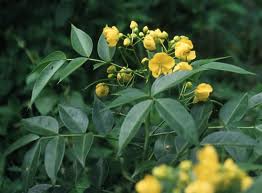| PlantID | 0061 |
| Botanical Name | Cassia occidentalis |
| Common Name | Coffee senna |
| Classification | | Kingdom: | Plantae | | Subkingdom: | Tracheobionta | | Division: | Tracheophyta | | Class: | Magnoliopsida | | Subclass: | Rosidae | | Order: | Fabales | | Family: | Fabaceae | | Genus: | Cassia | | Species: | occidentalis |
|
| Part used | Seeds, leaves and root. |
| Medicinal Properties | Diuretic, purgative, antiperiodic. |
| Medicinal Use | Whooping cough, convulsion, throat inflammation, colds, asthma, fever, flu and againsts poisonous snake bites. Seeds and leaves are applied externally in skin diseases. |
| Chemistry | Pericarp: C-flavonosides of apigenin; Flowers: emodin,physcion and its Beta-glucopyranoside; Seeds: chrysolein, linoleic, linolenic and oleic acids, campesterol; 8-carbomethoxy-1, 7-dihydroxy-3-methylxanthone (cassiollin=pinselin), helminthosporin, islandicin, xanthorin, N-methyl morpholine, tannic acid and toxalbumin; Leaves: aloe-emodin, bianthraquinone, chrysophanol, dianthronic heterosides, rhein and potassium chelidonate; Roots:chrysophenol, emodin, physcion, 1,7-dihydroxy-5-methoxycarbony-1-3-methylxanthone and Beta-sitosterol; |
| Cultivation | NA |
| Regional Habitat | Throughout Rajasthan, growing abundantly on wastelands immediately after the rains. |
| Description | An eract tropical annual herb with leathery compound leaves growing up to 6 feet tall. The seed poda are dark brown and curve slightly upward, the seeds are olive brown and flattened on both ends. The seeds, which are in long pods, can be roasted and made into a coffee-like drink. |
| Image |  |


